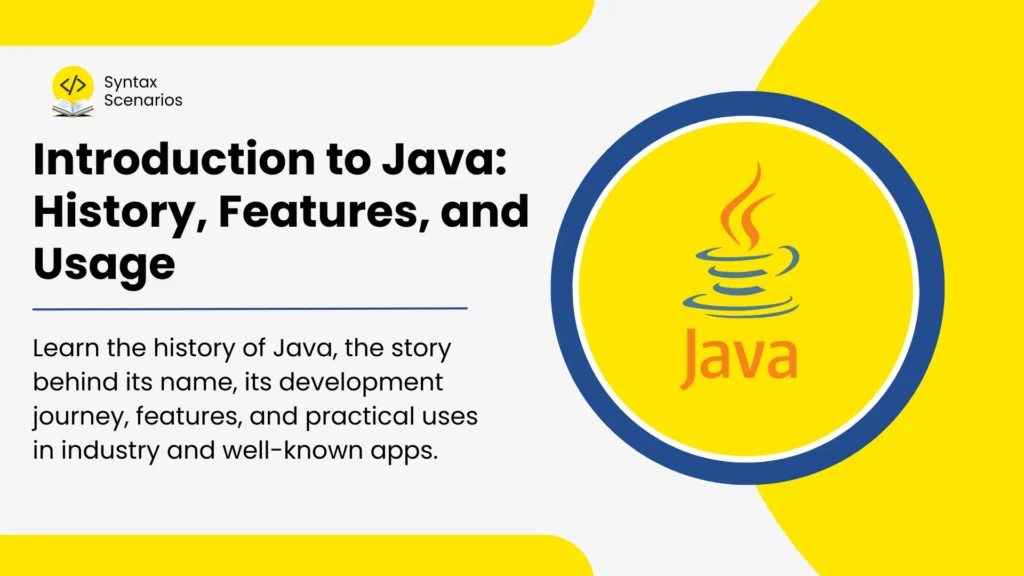Learn the history of Java, the story behind its name, its development journey, features, and practical uses in industry and well-known apps.
Table of Contents
History of Java
Java is a high-level, object-oriented programming language that James Gosling developed with his team at Sun Microsystems Inc. in 1995 (currently owned by Oracle Corporation). The phrase “write once and run everywhere” or “WORA” is often associated with this language. Because the goal is to relieve developers from writing codes for each platform separately. Java is well-known for its features like security, robustness, and simplicity making it a popular choice for enterprise-level applications.
The Story – How Java was Named as Java
The history and story behind the naming of Java is very interesting. This language was named “oak” initially because of the oak tree outside James’s office. But unfortunately, a search discovered that the name Oak Technologies was already trademarked by a company that was an American supplier of semiconductor chips. Hence the name oak was dropped.
According to James, Java, and Silk were two popular options taken into consideration. Java is also the name of a beautiful island in Indonesia where Java coffee was produced. James chooses the name “Java” while having coffee near his office. Since Java was so unique, most of the team members agreed on Java more than other names. And that’s why you see the coffee symbol as Java’s logo. Java released its first version “Java 1.0” in 1995. Now, around 6 billion devices run Java.
Key Features of Java
Java is known for several key features that make it a powerful programming language. Here are some of the most significant features:
Object Oriented Programming Language
Java follows an object-oriented programming paradigm which is based on the concept of classes and objects. The basic concepts involved in OOP are Abstraction, Encapsulation, Inheritance, and Polymorphism. By incorporating these concepts and principles in code, Java developers can create a well-structured and modular code that is simpler to understand, modify, and extend also ensuring flexibility, code reusability, and maintainability.
Platform Independence
To understand platform independence, think of a movie streaming service that allows the same movie to be streamed on multiple devices like laptops, smartphones, tablets, etc. without requiring separate versions for every single one of them.
By Java’s “write once and run anywhere” capability, code is written once and executed in any environment. Java’s compiler compiles the source code and converts it into bytecode. This code is converted to the machine code of the underlying OS. That’s why Java programs can run on any platform whether it is Windows, Linux, or Mac O/S.
You might have seen Java’s logo in your mobile games if you are a 90s kid.
Multi-threading
Imagine a busy restaurant kitchen during peak hours. The kitchen needs to handle multiple orders at once, to serve customers efficiently multiple chefs will work on different parts of different dishes simultaneously to prepare various dishes. This is a real-world example of multi-threading.
Java allows built-in support for multithreading, a mechanism in which a single program is divided into 2 or more threads/mini-processes that execute simultaneously on a single processor. The main advantage of this feature is that it does not occupy separate memory for each thread. Each has a common memory area that leads to better use of CPU resources.
Robustness
Think of a car that is built to be highly strong, reliable, and requires little maintenance from the driver. This self-maintaining car has built-in systems to monitor its performance, detect issues early, and automatically handle regular maintenance tasks. This is what we call robustness.
Java is well known for its robustness, a feature that facilitates the development of reliable and error-free applications. This robustness is mainly because of the three most important features. One is exception handling, which allows developers to easily handle and recover from unexpected failures. The second one is garbage collection whose function is to collect all the unused variables and provide automatic memory management. The third one is Java does not have pointers that cause security issues and errors in the program.
How is Java Different from other Programming Languages?
Here are some features that make Java a versatile language and a popular choice among other programming languages
| Aspect | Java | Other languages (C, C++) |
| Programming Paradigm | Java is an object-oriented programming language. | Memory management is done automatically through the mechanism of garbage collection. |
| Compilation and Interpretation | Java is both compiled and interpreted. | C and C++ can only be compiled. |
| Platform Independence | Java code is compiled into bytecode which can run on any platform. | C and C++ are platform-specific i.e. code needs to be compiled separately for each platform. |
| Memory Management | Memory management is done automatically through the mechanism of garbage collection . | C and C++ require manual memory management, leading to potential memory leaks. |
| Security | Java includes built-in security features like a bytecode verifier and a strong security manager. | C and C++ have fewer built-in security features and are more prone to security issues. |
Practical Uses of Java
Java is used in many different areas because it can work on any system, due to its platform independence, robustness, and extensive ecosystem. Here are some practical uses of Java:
Mobile App Development
Java has a huge role in mobile app development, particularly for Android applications. Java is the main programming language that the Android platform supports, offering robust tools, extensive libraries, and strong community support. Developers use it to make scalable, interactive, and reliable mobile applications in Android Studio, from gaming to enterprise/business solutions and social networking sites. A significant portion of the popular platforms like Netflix, and Spotify, are developed in Java.
Many well-known games that have captured the attention of players all over the world were developed with Java ME (micro-edition). The timeless classic Minesweeper, a logic puzzle video game generally played on personal computers, has been adapted into Java versions. Also, there is no need to introduce Minecraft. This is by far the most iconic game of the twenty-first century. Similarly, Asphalt 6, a thrilling racing game, showcases Java’s ability to handle high-speed graphics and complex gameplay controls on mobile devices.
Artificial Intelligence
Java’s infrastructure has intelligent software integrated inside it to improve AI programming. It has extensive libraries and frameworks for machine learning, deep learning, and natural language processing. It offers several incredible features, like better user interaction, simpler debugging, easily integrated features, standard interface tools, and much more. The Artificial Intelligence method is made error-free by the use of Java.
Enterprise Desktop Applications
Java is heavily used in enterprise environments for building large-scale applications because of its high degree of reliability, ability to scale with business needs, and compatibility with other systems. Because of this, Java is an ideal language to use when developing complex applications such as banking platforms, customer relationship management (CRM) software, and other business applications. Also, Java’s strong performance and security features ensure that these applications run smoothly and securely. Furthermore, developers may create reliable and efficient enterprise systems that can handle huge amounts of data and transactions.
Conclusion
To sum up, Java is a versatile and powerful programming language that is widely used across different areas because of its platform independence, reliability, and variety of tools. Whether you are making apps for Android, building large websites, or creating advanced software for businesses, Java provides the flexibility and support needed to tackle complex projects. Its popularity and ease of use make it a preferred choice for programmers of all skill levels, maintaining its ongoing popularity in the coding world.

